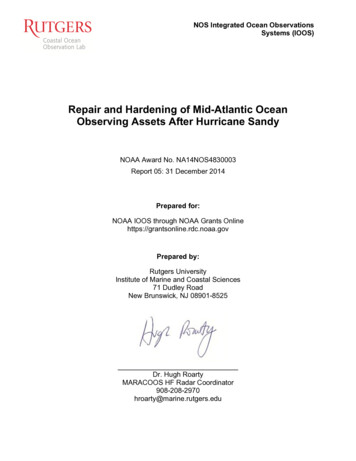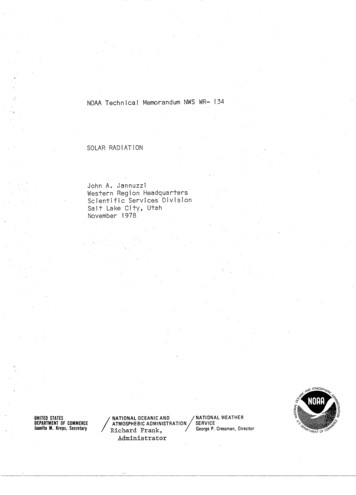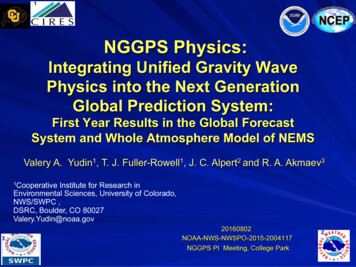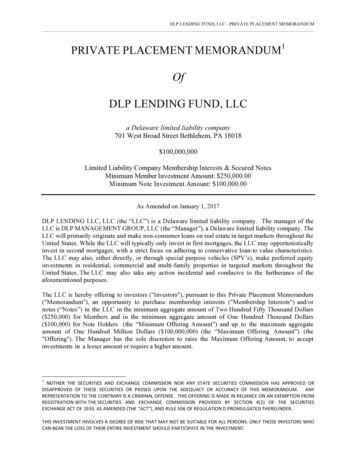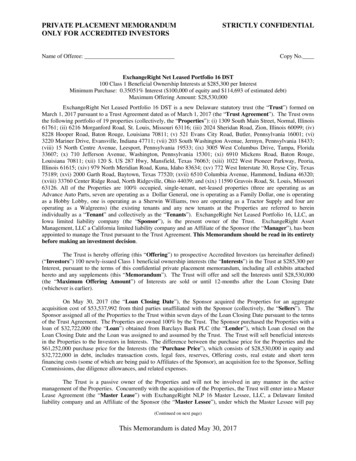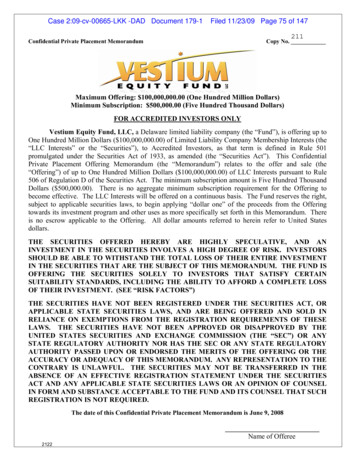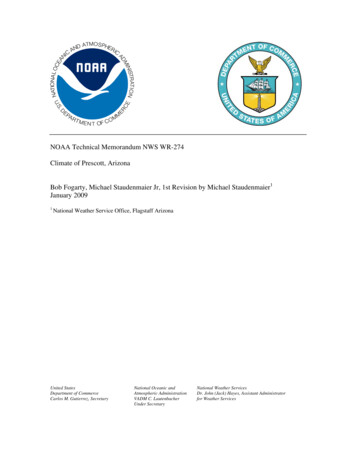
Transcription
NOAA Technical Memorandum NWS WR-274Climate of Prescott, ArizonaBob Fogarty, Michael Staudenmaier Jr, 1st Revision by Michael Staudenmaier1January 20091National Weather Service Office, Flagstaff ArizonaUnited StatesDepartment of CommerceCarlos M. Gutierrez, SecretaryNational Oceanic andAtmospheric AdministrationVADM C. LautenbacherUnder SecretaryNational Weather ServicesDr. John (Jack) Hayes, Assistant Administratorfor Weather Services
And is approved for publication byScientific Services DivisionWestern RegionAndy Edman, ChiefScientific Services DivisionSalt Lake City, UT
CONTENTSI.PageClimate of Prescott, Arizona .1Climate Summary .5II.Temperature RecordsDaily Maximum and Minimum Temperature Extremes.7Highest and Lowest Average Temperatures by Month .19Warmest and Coldest Winter, Spring, Summer, and Fall.22Highest and Lowest Annual Temperatures.24Average Number of Days Per Year with Maximum Temperatures85, 90, and 95 Degrees or Higher .24Average Number of Days Per Year with Minimum Temperatures40, 32, and 10 Degrees or Lower.25Freeze and Growing Season Data .25Greatest Number of Consecutive Days with Maximum Temperatures90 degrees or Higher.26Greatest Number of Consecutive Days with Maximum Temperatures95 degrees or Higher.26Greatest Number of Consecutive Days with Maximum Temperatures100 degrees or Higher 27Greatest Number of Consecutive Days with Minimum Temperatures10 degrees or Lower.27III.Precipitation RecordsGreatest Daily 24-Hour Precipitation (7 A.M. to 7 A.M.).29Maximum and Minimum Precipitation by Months .32Wettest and Driest Seasons.34Yearly Precipitation Totals .3615 Wettest and Driest Precipitation Years .37Greatest Number of Days with 0.01 Inch and 0.10 Inchor More, with Average Number of Days .38Greatest Number of Days with 0.25 Inch and 0.50 Inchor More, with Average Number of Days .38Greatest Number of Consecutive Days with 0.01 Inchand 0.25 Inch or More.39Greatest Number of Consecutive Days with 0.50 Inchand 0.75 Inch or More.40Greatest Number of Consecutive Days without Measurable Precipitation .40Excessive Storms .41Greatest Daily 24-Hour Snowfall .42Maximum Monthly Snowfalls .45
First and Last Snowfalls .46Seasonal Snowfall Totals.4715 Snowiest and Least Snowy Seasons .48Greatest Number of Days with Snowfall of One Inch or More andThree Inches or More.49Greatest Number of Days with Snowfall of Six Inches or More.49Snowiest Calendar Days .50Snowiest Consecutive Two Calendar Days .50Excessive Snowstorms.51Number of Days with Snowfall of 1 Inch or More.51IV.Miscellaneous InformationNormal Heating and Cooling Degree Days .53Monsoon Statistics .54Normal Daily Maximum, Minimum, and Mean Temperatures.55Sunrise and Sunset Table .68
I. NARRATIVE GEOGRAPHICAL AND CLIMATOLOGICAL SUMMARY
Winter weather typically beginsby November and becomes wellentrenched by December, withincreasingly colder weather. ByDecember, minimum temperatures aregenerally in the low 20s; howeverafternoon maximum temperatures stillaverage in the 50s, due to the amount ofsunshine the station receives.CLIMATE OF PRESCOTT,ARIZONAPrescott is located at the foot ofthe northern end of the BradshawMountains in central Arizona at 5200feet elevation. To the south of the citythe mountains rise to peaks of 7900 feet;to the north the terrain slopes gentlydown the valley of Granite Creek to itsjunction with the Verde River.By mid-April, winter weatherusually begins to break, and warm spellsbecome more frequent. Spring inPrescott is typically breezy and dry withlittle precipitation occurring in May andearly June.Prescott s elevation of 5200 feetassures a variety of weather includingcool winters, warm summers, moderatehumidity, and considerable diurnaltemperature changes. Only limitedfarming is carried on because of therelatively short of the growing season.The average date of the last occurrenceof 32 F in the spring is May 16 and thatof the first 32 F temperature in the fall isOctober 10. The average precipitationfor Prescott is 19.19 inches.There are two distinct periods ofprecipitation in Prescott. One occursduring the winter months fromNovember through April when the jetstream is located over the state, allowingmoist Pacific storm systems to moveover the area. The other distinct periodis classified as the summer rainy season,or summer monsoon. The monsoonrainy period usually occurs during Julyand August when most of Arizona issubjected to widespread thunderstormactivity. These thunderstorms areextremely variable in intensity andlocation and occur mainly between thehours of 12 p.m. and 8 p.m.Summers in Prescott have anaverage maximum temperature (averagemaximum for June, July and August) of86.2 F (the all-time record high is105 F). On average, only 37 days in thesummer have maximum temperatures of90 F or higher. Summer minimumtemperatures are cool and refreshingwith low temperatures mainly in the 50s.Since there is no concentration ofindustry, smoke pollution is almostnonexistent, and the air is remarkablyfree of contaminants of any kind,although smoke from resident sfireplaces can accumulate on some of thecolder nights due to strong radiationalinversions that develop. Smoke fromprescribed burning, and more rarely aforest fire, can also be an occasionalissue during the spring, early summerand later in the fall.The moderate summer heat givesway to a cooler but nonetheless pleasantfall period with average maximumtemperatures generally ranging from80 F down to 50 F by the end of theseason and minimum temperaturesnormally falling below freezing by themiddle of October.1
A HISTORY OF WEATHEROBSERVATIONS AT PRESCOTTPlant on Sun Dog Ranch Road. This iswhere the observations are taken today.The first official weather stationin Prescott was established May 1, 1898.The office was located at 140 SouthMcCormick Street. The first observerwas Dr. Warren E. Day.In addition to this station there isan automated site at Love Field.Observations have been taken theresince July 2, 1948. On February 3, 1999the Automated Surface ObservingSystem (ASOS) was installed andcontinues to provide 24 hours per dayobservations.In May 1908, the station wasmoved to the Pamsetgaaf Sanitorium,which was one-half mile west southwestof the previous location. The wordPamsetgaaf is an acronym for Pure Air,Maximum Sunshine, EquableTemperature, Good Accommodation,and Food. The station was moved to aslightly lower elevation site in 1924, butremained on the sanitorium grounds.SOME HIGHLIGHTS OF THEWEATHER RECORDS INPRESCOTTMany unusual weather eventshave taken place in Prescott sinceofficial weather observations began onMay 1, 1898. The following is a briefdescription of some of the more extremeconditions recorded.On December 21, 1937, theweather station was moved to 617 EastWillis Street.During the 1940s the stationexperienced several moves. The firstoccurred on June 1, 1940 to 233 NorthVirginia. Then on July 5, 1944, thelocation was moved to the ArizonaHighway Department about one-halfmile southeast of the previous locationon North Virginia.The all-time record hightemperature for Prescott of 105 Foccurred on July 17, 1925. It occurredduring a short heat wave. Four days outof the six day period from the 13ththrough the 18th had high temperaturesof 100 F or greater, and on the 17thPrescott also set a record high lowtemperature of 70 F.On August 12, 1945, the weatherstation moved to the Prescott Fire Hallon Cortez Street where it stayed until1956. On February 24 of that year theobserving location moved to RadioStation KYCA one mile northeast of thePrescott post office.The all-time record warmestminimum temperature for Prescott wasfirst set on July 15, 2003 when themercury fell to only 76 F. It was thentied on July 6, 2007 when the sametemperature was recorded for theminimum temperature.On January 1, 1970, the weatherstation moved to 601 Flora Street. Itremained on Flora Street until 1983when it made one final move on April 25to the Sun Dog Wastewater TreatmentThe longest consecutive stretchof days with maximum temperatures of95 F or greater in Prescott was 17 days.This occurred during June 20 - July 6,1929. The highest temperature reached2
The most precipitation everrecorded in one calendar year at Prescottwas 39.47 inches, set during 1905. Theleast precipitation recorded in onecalendar year at Prescott was 3.41inches, set in 1907. The average annualprecipitation for Prescott is 19.19 inches.during this longest stretch of warmweather was 103 F.The longest consecutive stretchof days with maximum temperatures of90 F or greater in Prescott was 33 days.This occurred during June 18 - July 20,1905.The all-time record for heaviestprecipitation during any calendar day atPrescott was 4.28 inches which was seton November 27, 1919. This day was inthe middle of one the wettest periods ofPrescott’s weather history during which5.23 inches fell in a six day period. Theentire event ended with an accumulationof 13 inches of snow.The maximum number of days ina calendar year with temperatures of95 F or greater was 35 set in 1905. Themaximum number of days in a year withtemperatures of 90 F or greater was 81days which was set in 1933The coldest temperature everrecorded in Prescott was -21 F whichwas observed on January 22, 1937.Although the temperature warmed 47degrees that afternoon, the maximum of26 F was still the record low maximumfor the date.The most precipitation to occurwithin a continuous stormy periodoccurred from February 11-19, 1927when in excess of 10.59 inches fell. Theexact total is not known, because on the13th the record shows there were 5.0inches of snowfall and 0.00 inches ofprecipitation. It is possible that the actualtotal for the nine day period wasbetween 11 and 12 inches.The maximum number ofconsecutive days with minimumtemperatures of 10 F or lower was 12days. This has happened twice; firstfrom December 15-26, 1928 and againfrom December 28, 1932-January 8,1933.Because of this excessiveprecipitation event, February 1927 wasthe wettest month on record, with 10.59inches of precipitation falling during themonth.The maximum number of days ina calendar year with temperatures of10 F or lower was 32 days set in 1933.The maximum number of days in anymonth with temperatures of 10 F orlower was 23 days set in the extremelycold month of January 1937. Theaverage minimum temperature thatmonth was 3.8 F which was about 20degrees below normal. Of those 23 days,14 had low temperatures equal to orbelow 0 F and included the all timerecord low temperature.The average yearly snowfall inPrescott is 20.4", but is extremelyvariable from year to year. The mostsnowfall ever recorded during the snowseason (July - June) was 97.4 inches in1931-32. On the other extreme, severalseasons have recorded no snowfall, themost recent in 1913-14.3
total of 99 days! The greatest number ofconsecutive days with measurableprecipitation was 13 set during theperiod of July 6-18, 1953, when a totalof 5.42" of precipitation fell.The snowiest day in Prescott’sweather history was January 11, 1930when 21.8" fell. This was in the middleof the most snowfall to occur within acontinuous stormy period. From January10-13, 1930 there was 39.5" of snowmeasured.The greatest number ofconsecutive days with measurablesnowfall was 6 days set three times,most recently from February 11-16,1978. Interestingly, there were only 6.0"of snow during this period. The othertwo six day periods are on the list ofexcessive snow storms.January 1949 was the snowiestmonth with 53.0” recorded.The greatest number ofconsecutive days without measurableprecipitation was recorded fromSeptember 25, 1999 – January 1, 2000, a4
CLIMATE SUMMARYTEMPERATURE*RECORD NORMAL1 NORMAL1 NORMAL1 AL105-211 Climatological normals 1971-2000.* All values are 1.421.31.286.962.746.019.1939.471 Climatological normals 1971-2000.** All values are inches.520.497.4
II. TEMPERATURE RECORDS6
DAILY MAXIMUM AND MINIMUM TEMPERATURE EXTREMESMAY 1898 - DECEMBER 2008MONTH: 94819272003194819692002 1953195319902002 194319431975197419711971197119712000 19101970 1951 19751942 200319861971 2126253030353530293022Year1960 1907194919491910191319711971 19891937191319631963193020071960 19601987193519371937193719371949 192919021979 19491979 038394244374041404240403941Year1982 1938199719001991 19911993 199319572005 200519401957198019381911 20002000 1959 1965197119671956 195019952000 1975190119361963 1971189919371937 19131963196419621949 19281937 19351935193719371937192919371937197919491949 19491979 Month731971 211937 491997-211937 Also occurred in prior years.7
DAILY MAXIMUM AND MINIMUM TEMPERATURE EXTREMESMAY 1898 - DECEMBER 2008MONTH: 72727275737071717575777474Year2003 200319341963196319631963 196319961926192619101957195719711996197719771935 198119771982 20021989 0195719761978 191919162003200319801962195519861986 1996199619011918191819101940 1988 2101095-214Year19491939 19221933198518991903 1929192919331939 19652004 19051942199019111975 193319551955195319131960 1977 1912199619131904Month771986201905481996 -121899 Also occurred in prior years.8
DAILY MAXIMUM AND MINIMUM TEMPERATURE EXTREMESMAY 1898 - DECEMBER 2008MONTH: 019101910197219721972 19891989 19001900200719342007 200720072004200420042004 3843Year19531971 19661976197619452000193519351962 1952200620061973196919911991198619351985 19521991 04451Year1938 19201986 199519952001200119601954 1954198519602004200819612003199419931959 1939 2001 200120012001 19982001 1948194519451969 19221935194819691956 1952192419171925 1899193519041904192319171929196419021942 197519751976 1938 Month811934301971 512001 21913 Also occurred in prior years.9
DAILY MAXIMUM AND MINIMUM TEMPERATURE EXTREMESMAY 1898 - DECEMBER 2008MONTH: 686858484848687858587868587Year19661959 196119611960 1972 19301989 19891989193419341937 19361936194819361962198919301965 1989 1949194919271996 2000 20002007 2219751919196520011965 192719761976199819761995 196819711995 555Year2001200120011967 87 19192001193819971958191919192002191019961999 55 221933192319631967 1960190418991899197019701904 Month872000 341925581938 111925 Also occurred in prior years.10
DAILY MAXIMUM AND MINIMUM TEMPERATURE EXTREMESMAY 1898 - DECEMBER 2008MONTH: 7193419342008 2008 20052005 20002001 19511974 2003 575852505354585451586062615261Year1915191519051959 193019301971 19861979197919571933193319511951194419811977 1917191719791975200819652008 71996198919332004 19891997 200019911962196219931996 1984193819962001 19481934200820082006 19841943200119432005200319861984 11*1929*19531918 1921 Month971910411915 622008 201915* Also occurred in prior years.* 1899 data considered suspect. See note on page 19.11
DAILY MAXIMUM AND MINIMUM TEMPERATURE EXTREMESMAY 1898 - DECEMBER 2008MONTH: 02192619221996 19962006 192819551996 19211936193319331940 19401940194019361940 19361936 195419291929192919291994 190019241994 7776747176777176Year199119911999 19151999192519931995199519681976 1928195519211973 19211995199519671975197519941972 1972196519651913191019881986 56668656766707070Year1910191019241956 20062006200620001990199620081918195919991960 2000200019631925198919882005193720062006 291908192519331954 195019501968 195419471950 1970 1901190119231939 19231921192319471948 1930 194119011965194119131933 Month1031994 571999 722000251899 Also occurred in prior years.12
DAILY MAXIMUM AND MINIMUM TEMPERATURE EXTREMESMAY 1898 - DECEMBER 2008MONTH: 0210199Month105Year1947 1947 1985 200720071905190519051956 19001900190019392005 19341998 1925200519011937193719321936 1996 1943193118981995 199518981978 67195019501937 19301930 98 176 Also occurred in prior 07 20072004200419472003197019252005 37464545454445464546Year1982 192819121935 192119021903 19021926 1902193619021944 19441962190319241924189819241898190119131913 1944190319131913 1913 190319032007 341912
DAILY MAXIMUM AND MINIMUM TEMPERATURE EXTREMESMAY 1898 - DECEMBER 2008MONTH: ar19381993 19181904199419051905199519281937 19371937 1933193318981898190519051928192819381991 19361931 19851924192419241998 71727173645869736971666867190558Year1963 2003 1988 195120001913 9941994196919611995 1956199420022002 19621992 19112002200219601997199120052006 19641994198820012008 2008 4243324043414141424238Year1950 1903190319761924192819281951 1949 194919491949 1949 18991968191818991938 1899190919791979196819681948194019541932 1920196419571962 321968 Also occurred in prior years.* August 1904 data not included due to potential errors – see page 19.14
DAILY MAXIMUM AND MINIMUM TEMPERATURE EXTREMESMAY 1898 - DECEMBER 2008MONTH: 719321955 193619321947 19321990 1948 19051905200019321928195619341928 1943 54Year1967 1967 061906194019651965197819652004 19861986 9952002 196319952002189920052003195719691993 1967 1990199719972007194319431983200020071954 20032003 1997 190919401951 30303028272728272930Year195719511964 19611961 19361948 1935194119121912 19061952193019031903190319031978 19781978191219011923191719241924 1934 19001965 Month981950 521986671995261903 Also occurred in prior years.15
DAILY MAXIMUM AND MINIMUM TEMPERATURE EXTREMESMAY 1898 - DECEMBER 2008MONTH: 80198019801980 19342000 19441996 199619961950199219181905199119242003 19212003 200320032003195919591959 19262008 19622008 2001 5047525043464034421980 34Year19191959 1941 1968191219121993 491920 048515050197161 Also occurred in prior years.16Year19332003200319401963 2006 1975 194519451905 1996 190819051996 192919362005 20051979200420042001194219601939198219052001 196919131913192719491982 19242008200820081966 19811938 191719321949194919081906197519751953 191719701961197119352003131935
DAILY MAXIMUM AND MINIMUM TEMPERATURE EXTREMESMAY 1898 - DECEMBER 2008MONTH: 837675797574757475767677737273Month83Year19161931 192419241988 19342007 19261973 1980 1934197319991999 1999 981980 39393030363434363732193330Year1972 19361974 197419572000 2000191919661915200019721985198519641964 195819641930199419791947 19311931193119881973 1919 1975 244425049434442374041193155 Also occurred in prior 95 1978 19831983196219421913196519821977 190919551900190919651921 195819262008 1970 71010935Year192919561956193519351947 19381945194819461950 1929191619161956 1964 1964 1958196419561956 1929193119311931190219731948191919751960-11931
DAILY MAXIMUM AND MINIMUM TEMPERATURE EXTREMESMAY 1898 - DECEMBER 2008MONTH: 6873746968696869706566676870706869Month78Year1995 19261954 197719792007 19771939193819811950195018991996 194619391939198019791917 2003196919172005 19251955 91199119131913 200119601978197819781932 194919491992 871987 2008 1932 238444038434344444238444141199048 Also occurred in prior years.18Year2007196019541954 571978 1962192119591921197119831971197119831984 2-5-4-8-9-6-2100-1-2Year2006 1991193419031948 19311978197819781978 90192419241924192619261916191119111918-91931
HIGHEST AND LOWEST AVERAGE TEMPERATURES BY MONTHWITH YEAR OF OCCURRENCE(May 1898 – December stSeptemberOctoberNovemberDecemberNormal* HighestMonthly 9681912191919471932* Climatological normals from the years 1971-2000.* The record shows that 20 days during May 1899 had a record low minimum for the entireperiod of record. This seems highly unlikely. In addition to the large number of days, more thanhalf of them had a record low that was 5 or more degrees lower than the next lowest temperaturefor the date. It seems likely that many of the record lows recorded in May 1899 are erroneous.So, if the low temperature on a day in May 1899 was more than 3 degrees lower than the nextlowest temperature, it was replaced with the second lowest temperature. The dates marked withan * on page 10 and above utilize this methodology.Additionally, during the month of August 1904, all overnight minimum temperatures wererecord maximum values for the entire period of record, which is also highly unlikely. These datahave not been used for purposes of ranking in this book.19
HIGHEST AND LOWEST MONTHLY AVERAGE TEMPERATURES(May 1898 – December 2008)Highest MonthlyAverageTemperatureLowest 061.561.962.762.763.419651923194119671982* Monthly normals based on climatological normals 1971-2000.** See note on page 18 regarding May 1899.20
HIGHEST AND LOWEST MONTHLY AVERAGE TEMPERATURES(May 1898 – December 2008)Highest MonthlyAverageTemperatureLowest earJuly73.478.677.377.277
The coldest temperature ever recorded in Prescott was -21 F which was observed on January 22, 1937. Although the temperature warmed 47 degrees that afternoon, the maximum of 26 F was still the record low maximum for the date. The maximum number of consecutive day

